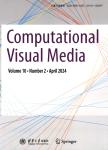Dynamic skin deformation simulation using musculoskeletal model and soft tissue dynamics
Dynamic skin deformation simulation using musculoskeletal model and soft tissue dynamics作者机构:National Institute of Advanced Industrial Science and TechnologyTokyo135-0064Japan Carnegie Mellon UniversityUSA Disney ResearchUSA
出 版 物:《Computational Visual Media》 (计算可视媒体(英文版))
年 卷 期:2017年第3卷第1期
页 面:49-60页
核心收录:
学科分类:08[工学] 080203[工学-机械设计及理论] 0835[工学-软件工程] 0802[工学-机械工程] 0811[工学-控制科学与工程] 0812[工学-计算机科学与技术(可授工学、理学学位)]
基 金:National Science Foundation NSF
主 题:three-dimensional graphics and realism musculoskeletal model quasi-static muscle model dynamic skin deformation
摘 要:Deformation of skin and muscle is essential for bringing an animated character to life. This deformation is difficult to animate in a realistic fashion using traditional techniques because of the subtlety of the skin deformations that must move appropriately for the character design. In this paper, we present an algorithm that generates natural, dynamic, and detailed skin deformation(movement and jiggle) from joint angle data sequences. The algorithm has two steps: identification of parameters for a quasi-static muscle deformation model, and simulation of skin deformation. In the identification step, we identify the model parameters using a musculoskeletal model and a short sequence of skin deformation data captured via a dense marker set. The simulation step first uses the quasi-static muscle deformation model to obtain the quasi-static muscle shape at each frame of the given motion sequence(slow jump). Dynamic skin deformation is then computed by simulating the passive muscle and soft tissue dynamics modeled as a mass–spring–damper system. Having obtained the model parameters, we can simulate dynamic skin deformations for subjects with similar body types from new motion data. We demonstrate our method by creating skin deformations for muscle co-contraction and external impacts from four different behaviors captured as skeletal motion capture data. Experimental results show that the simulated skin deformations are quantitatively and qualitatively similar to measured actual skin deformations.



